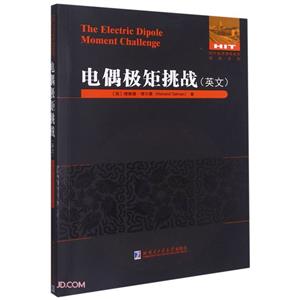-
>
宇宙、量子和人類心靈
-
>
氣候文明史
-
>
南極100天
-
>
考研數(shù)學(xué)專題練1200題
-
>
希格斯:“上帝粒子”的發(fā)明與發(fā)現(xiàn)
-
>
神農(nóng)架疊層石:10多億年前遠(yuǎn)古海洋微生物建造的大堡礁
-
>
聲音簡(jiǎn)史
電偶極矩挑戰(zhàn)(英文) 版權(quán)信息
- ISBN:9787560396347
- 條形碼:9787560396347 ; 978-7-5603-9634-7
- 裝幀:一般膠版紙
- 冊(cè)數(shù):暫無(wú)
- 重量:暫無(wú)
- 所屬分類:>
電偶極矩挑戰(zhàn)(英文) 內(nèi)容簡(jiǎn)介
本書共包括10章, 第1章詳細(xì)地說(shuō)明了電偶極矩 (EDMs) 的可測(cè)量程度可能表示標(biāo)準(zhǔn)模型不完善的程度 ; 第2章簡(jiǎn)要介紹了一些已經(jīng)實(shí)行的EDMs實(shí)驗(yàn) ; 第3章討論了磁場(chǎng)中的磁偶極矩 (MDMs) 的進(jìn)動(dòng) ; 第4章包含“足夠多的加速器物理學(xué)的知識(shí)” ; 第5章介紹了需要EDM測(cè)量?jī)?chǔ)存環(huán)的全電彎曲場(chǎng)的質(zhì)點(diǎn)力學(xué) ; 第6、7章介紹了“自磁存儲(chǔ)環(huán)格” ; 第8章介紹了計(jì)劃中的儲(chǔ)存環(huán)和EDM測(cè)量 ; 第9章介紹了相對(duì)論 ; 第10章著重于對(duì)電子束的S-G偏轉(zhuǎn)的介紹。
電偶極矩挑戰(zhàn)(英文) 目錄
Author biography
1 Symmetry, physical laws, and electric dipole moments
1.1 Introduction
1.2 Force field symmetries
1.2.1 Vectors
1.2.2 Vectors and pseudovectors
1.2.3 Modern analog of the Ampere experiment
1.3 Why measure EDMs, which, and how?
2 Some essential experiments
2.1 Neutron EDM measurements
2.2 Penning traps and Penning-like traps
2.3 Electron EDM measurement using polar molecule enhancement
2.4 The future
References
3 Magnetic precessions
3.1 Cyclotron rotation, gyromagnetic ratio, and Larmor precession
3.1.1 Classical picture
3.1.2 Magnetic moment parameterization
3.2 Storage ring EDM measurement
3.3 Spurious magnetic precessions
3.3.1 Reducing the influence of environmental magnetic fields
3.3.2 Low frequency magnetic fields
3.3.3 Neutron EDM magnetic precessions
3.3.4 Magnetic noise comparison of neutron and proton EDM
experiments
References
4 Just enough accelerator physics
4.1 Preview
4.2 The uniform field ring
4.3 Horizontal stability
4.4 Vertical stability
4.5 Simultaneous horizontal and vertical stability
4.6 Dispersion
4.7 Momentum compaction
4.8 Chromaticity
4.9 Transfer matrices
4.10 Transfer matrices for simple elements
4.10.1 Drift space
4.10.2 Thin lens
4.11 Transfer matrix parameterization
4.12 Strong focusing
4.13 General transverse motion
4.13.1 Magnetic deflections
4.13.2 Element strengths and deviations
4.13.3 Nonlinear magnetic field example
Reference
5 All-electric particle dynamics
5.1 Background
5.2 Introduction
5.3 Particle tracking paradigms
5.4 Relativistic kinematics in central force electric field
5.4.1 Solution of the equation of motion
5.4.2 Rescaling of the MP-vector and updating the horizontal slope
5.4.3 Pseudoharmonic description of the motion
References
6 The all-electric Brookhaven electron storage ring
6.1 Introduction
6.2 Storage rings for frozen spin electrons or protons
6.2.1 Simulation of storage ring commissioning
6.3 The AGS Electron Analogue Ring
6.3.1 Reconstruction from historical BNL documents
6.4 Current day simulation of 1955 machine studies tune plane scan
References
7 A self-magnetometer storage ring
7.1 Abstract
7.2 Introduction
7.3 Orbit equations for the storage ring bottle
7.3.1 Distributed octupole field
7.3.2 Guiding center approximation
7.3.3 Fast-slow approximation
7.3.4 0ctupole restrained motion
7.4 Self-magnetometer precision
7.4.1 Compensation procedures
7.4.2 Calculated self-magnetometer precision
References
8 Frequency domain EDM experiment design
8.1 Introduction
8.1.1 - Review of fundamentals
8.1.2 Physics justification and current status
8.2 Proposed method
8.2.1 Definition of'nominal' EDM
8.2.2 The frequency domain 'advantage'
8.2.3 Tentative parameters
8.3 Error analysis strategy
8.3.1 Storage ring as 'charged particle trap'
8.3.2 Categorization of error sources
8.3.3 Thermal noise limited precision
8.4 Spin precession
8.4.1 Field transformations
8.4.2 MDM-induced precession in electric field
8.4.3 EDM-induced precession in electric field
8.5 Conquering ABr field errors
8.5.1 Qualitative discussion
8.6 Roll-reversal accuracy
8.6.1 Wien filter design
8.6.2 Roll-reversal symmetry
8.6.3 Determination of roll reversal accuracy
8.7 Other calculations
8.7.1 Geometric phase errors
8.8 Recapitulation and conclusions
References
9 The Bargmann-Miehel-Telegdi equation
9.1 Relativistic mechanics
9.2 Angular momentum 3-vector s
9.3 The momentum-weighted spin 4-vector W
9.4 Lorentz transformation of 4-spin components
9.5 The BMT equation
9.6 Special cases of spin precession
電偶極矩挑戰(zhàn)(英文) 作者簡(jiǎn)介
理查德·塔爾曼,born in Toronto, Canada, BA and MA in Math at Western University, London, Ontario, received a PhD in Physics, Cal Tech, in 1962. He has been a professor (now emeritus) of physics at Cornell ever since, advancing through the ranks. Like all disciples of Robert Wilson, he has specialized co-equally in elementary particle physics and accelerator physics. Fellow of the American Physical Society. he is author or one of the principal authors of about 40 Physical Review Letters publications and about the same number of longer publications. He is the author of books Geometrical Mechanics (2nd edition), and Accelerator X-Ray Sources, and has supervised 19 successful PhD thesis candidates. He was group leader of the 'Instrumentation and Diagnostics Group' at the late, lamented, S.S.C. project in Texas. He has spent sabbaticals at CERN (twice), SLAC, the Central Design Group at Lawrence Berkeley Lab and at the Canadian Light Source in Saskatoon. He has taught numerous courses at the U.S. Particle Accelerator School, most recently a course 'All-Electric Accelerators' (for electric dipole measurement) at the University of California, Davis in 2017 (with the present book as text).
- >
龍榆生:詞曲概論/大家小書
- >
羅曼·羅蘭讀書隨筆-精裝
- >
【精裝繪本】畫給孩子的中國(guó)神話
- >
唐代進(jìn)士錄
- >
有舍有得是人生
- >
中國(guó)歷史的瞬間
- >
隨園食單
- >
回憶愛(ài)瑪儂

















